Strategie
Start of play
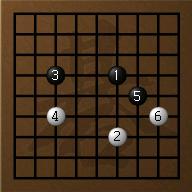
Usually, a game begins with the players being cut off large-scale territory and the boundaries are gradually tightened. Art is about finding the right measure. If one wants to have too much of the cake, it is easy for the opponent to hide a small area in his own area.
Two eyes
Anyone who has already played a few games will have noticed that even larger groups of stones can occasionally be beaten by the opponent. So how does a group have to look so that it can no longer be beaten? Here the rule helps: "A group with two eyes lives!"
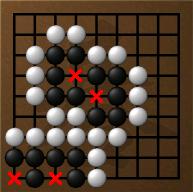
Two black groups can be seen in the picture, each having an eye at the places marked with X. If White wanted to beat these stones, he would have to play at both points. Only one of the two places to occupy is prohibited under the suicide rule.
Groups that have two eyes or those in which the opponent cannot prevent them from having two eyes at some point are strong. Having strong groups is always an advantage!

Attention: It is important here that all stones bordering the eyes are either connected to one another or to another eye; otherwise, as in the case of X, a false eye arises, since the two adjacent black groups are not connected to one another. If White would approach A, Black would have to connect his two groups to X and would have only one eye, namely B.

If black instead sits on C, it forms another eye on A and thus secures its survival.
Seki

In the next picture, none of the players want to play on one of the positions marked with X (why?). Such a situation is called Seki. The position remains on the board until the end of the game. For the two places marked with X, no player receives a point because they represent neutral territory.
Co-fighting
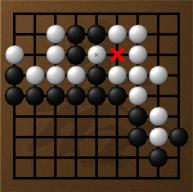
White has just hit a stone on X and threatens to put X on the next train and catch the group on top left. What to do?
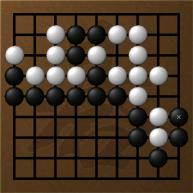
Black plays a so-called co-threatening, i.e. he plays a train to which white must respond if he does not want to risk greater damage, for example at the right margin in the picture.
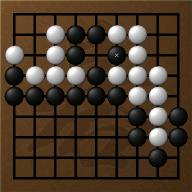
When White answers, Black can strike back the Co and now White has to find a co-threatening.
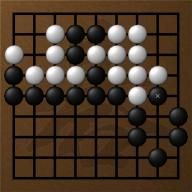
However, if white covers the co and catches the three black stones at the upper edge, then black gets two stones at the bottom right as compensation.
Endgame
If the game is close to the end, the deported areas become more and more clear, the boundaries are increasingly closed, there are only a few "lengths" in these boundaries. As always, it is important to weigh down what brings more points. For example, a train that makes only one point, but threatens great damage to the opponent to prefer another that makes more points, but leaves the opponent the initiative.

White now offer alternatives A or B: White plays on A, black is forced to prevent the penetration of white by setting on C. White can then connect its two groups to B.
Plays white first on B, black closes the border in return to A. This saves black one point from the other variant.

